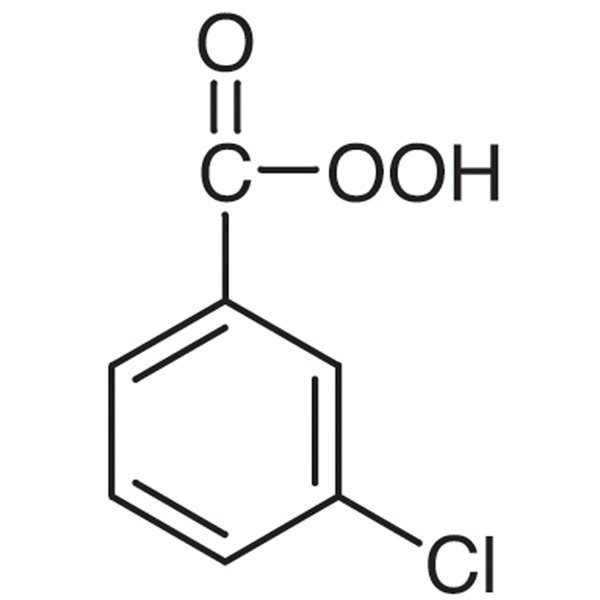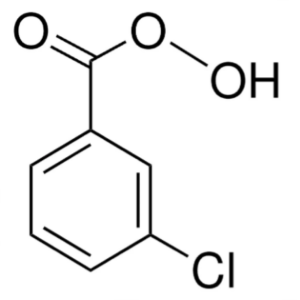3-Chloroperoxybenzoic Acid mCPBA CAS 937-14-4 Purity ≥85.0% (by Na2S2O3 Titration) (Wet with Water)
Shanghai Ruifu Chemical Co., Ltd. is the leading manufacturer of 3-Chloroperoxybenzoic Acid (mCPBA) (CAS: 937-14-4) with high quality. Ruifu Chemical can provide worldwide delivery, competitive price, excellent service, small and bulk quantities available. Purchase 3-Chloroperoxybenzoic Acid, Please contact: alvin@ruifuchem.com
| Chemical Name | 3-Chloroperoxybenzoic Acid (Wet with Water) |
| Synonyms | m-Chloroperoxybenzoic Acid; meta-Chloroperoxybenzoic Acid; 3-Chloroperbenzoic Acid; m-Chloroperbenzoic Acid; mCPBA; m-CPBA; 3-Chlorobenzenecarboperoxoic Acid; (Wet with Water) |
| CAS Number | 937-14-4 |
| Stock Status | In Stock, Production Scale Up to Tons |
| Molecular Formula | C7H5ClO3 |
| Molecular Weight | 172.57 |
| Melting Point | 69.0~71.0℃(lit.) |
| Density | 0.56 g/ml |
| Water Solubility | Insoluble in Water |
| Hazard Class | 5.2; Organic Peroxide |
| COA & MSDS | Available |
| Origin of Product | Shanghai, China |
| Brand | Ruifu Chemical |
| Item | Specifications | Results |
| Appearance | White Crystalline Powder (Wet with Water) | Conforms |
| Identification IR Spectrum | Conforms to Reference Spectrum | Conforms |
| Purity / Analysis Method | ≥85.0% (by Na2S2O3 Titration) | 86.6% |
| Water (by K.F) | ≤15.0% | <15.0% |
| 3-Chlorobenzoic Acid | ≤10.0% | <10.0% |
| Conclusion | The product has been tested and complies with the given specifications | |
Package: Bottle, 25kg/Drum, or according to customer's requirement.
Storage Condition: Store in sealed containers at cool and dry place; Protect from light and moisture. This product is stable under normal temperature and pressure. Keep away from flammable materials during storage. Avoid heat, Spark, burning, collision and friction.
Shipping: Deliver to worldwide by air, by sea, by FedEx / DHL Express. Provide fast and reliable delivery.
3-Chloroperoxybenzoic Acid (mCPBA) (CAS: 937-14-4) Method of Analysis:
Instrument: Electronic balance
Reagents and solutions:
Chloroform and acetic acid analytically pure
10% Potassium iodide solution: Take 10g Potassium iodide, add water to dissolve and dilute to 100ml, shake well, and then get.
Sodium thiosulfate titration (0.05mol/L): Take 26g of Sodium thiosulfate and 0.2g of anhydrous Sodium carbonate, add a suitable amount of newly boiled cold purified water, dissolve into 1000ml, shake well, and prepare 0.1mol/L Sodium thiosulfate titration. Leave for 1 month and strain.
The 0.1mol/L Sodium thiosulfate titration prepared before use was diluted with newly boiled cold water to produce 0.05mol/L sodium thiosulfate titrant.
0.5% (g/ml) starch indicator liquid: Take 0.5g of soluble starch, add 5ml of purified water, stir well, slowly pour into 100ml boiling water, add and stir, continue to boil for 2 minutes, cool, pour out the superwhite liquid, and get.
Determination: Take about 50mg of chlorperoxybenzoic acid, weigh it accurately, add 5ml chloroform to dissolve, add 10ml of 10% potassium iodide (sodium) solution and 5ml of acetic acid, and dilute it with 30ml of distilled water. After reaction for 10min, titrate with sodium thiosulfate titration solution (0.05mol/L), drop the brown-red solution (dark red solution) to light brown-yellow. At this time, add 0.5% (g/ml) starch indicator solution 1ml, continue titration until the water layer becomes colorless, that is, the end point. Each 1ml of sodium thiosulfate titrator (0.05mol/L) is equivalent to 4.31mg of C7H5ClO3. The measured content shall not be less than 83.0%. (≥83.0%)
Percentage of 3-Chloroperoxybenzoic Acid (C) is calculated as follows:
C=Vxcx0.00431/mx100%
Where: V - the volume of Sodium thiosulfate titration consumed by the sample, ml;
c - Sodium thiosulfate titration concentration, mol/L;
m - Sample mass, g;
Allowable deviation: The test subject should be measured twice in parallel, and the relative average deviation of the two test results should be no more than 0.3%, and the arithmetic average of the two test results should be taken as the reported result.
Relative average deviation:

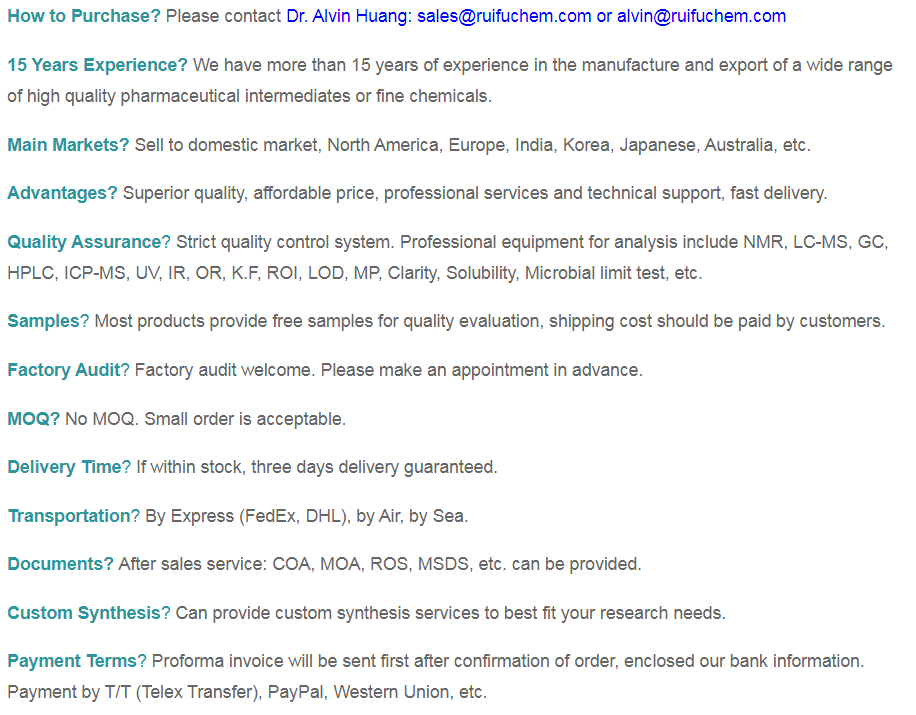
Risk Codes R5 - Heating may cause an explosion
R8 - Contact with combustible material may cause fire
R36/37/38 - Irritating to eyes, respiratory system and skin.
R43 - May cause sensitization by skin contact
R7 - May cause fire
R34 - Causes burns
R22 - Harmful if swallowed
Safety Description S17 - Keep away from combustible material.
S26 - In case of contact with eyes, rinse immediately with plenty of water and seek medical advice.
S36/37 - Wear suitable protective clothing and gloves.
S45 - In case of accident or if you feel unwell, seek medical advice immediately (show the label whenever possible.)
S36/37/39 - Wear suitable protective clothing, gloves and eye/face protection.
S3/7 -
S14 - Keep away from ... (a list of incompatible materials will follow).
S27 - Take off immediately all contaminated clothing.
S7/9 -
UN IDs UN 3106 5.2
WGK Germany 3
RTECS SD9470000
FLUKA BRAND F CODES 4.4
TSCA Yes
HS Code 2916399090
Hazard Class 5.2
Packing Group II
3-Chloroperoxybenzoic Acid (mCPBA) (CAS: 937-14-4) is a peroxycarboxylic acid. It is used widely as an oxidant in organic synthesis. mCPBA is often preferred to other peroxy acids because of its relative ease of handling.[1] mCPBA is a strong oxidizing agent that may cause fire upon contact with flammable material. mCPBA can be prepared by reacting m-Chlorobenzoyl chloride with a basic solution of hydrogen peroxide, followed by acidification. It is widely used in cyclization reaction, Baeyer-Villiger reaction, N-oxidation reaction and S-oxidation reaction. It can be used as oxidant for synthetic medicine, pesticide and other fine chemical products, and sometimes as bleaching agent. mCPBA is often preferred to other peroxy acids because of its relative ease of handling.
-
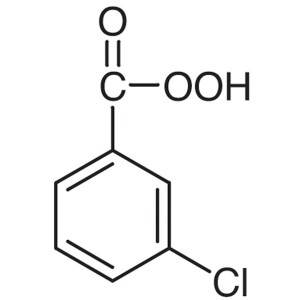
3-Chloroperoxybenzoic Acid mCPBA CAS 937-14-4 P...
-
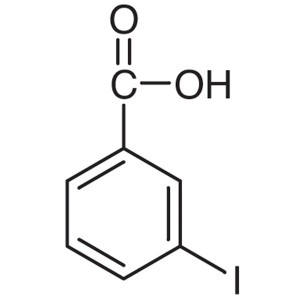
3-Iodobenzoic Acid CAS 618-51-9 Assay ≥99.0% (H...
-
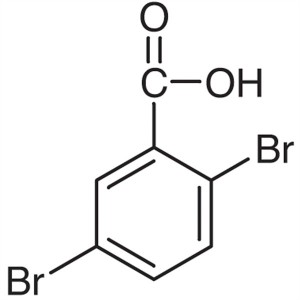
2,5-Dibromobenzoic Acid CAS 610-71-9 Assay ≥99....
-
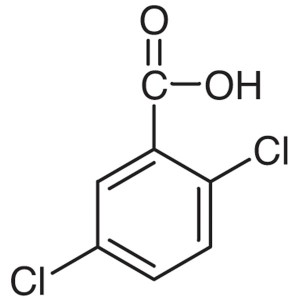
2,5-Dichlorobenzoic Acid CAS 50-79-3 Purity >99...
-
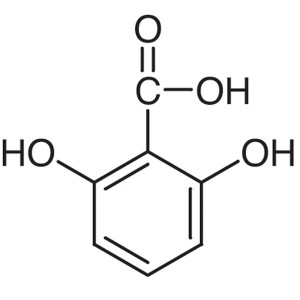
2,6-Dihydroxybenzoic Acid CAS 303-07-1 Assay ≥9...
-
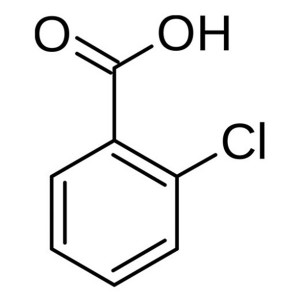
2-Chlorobenzoic Acid CAS 118-91-2 Purity >99.0%...
-
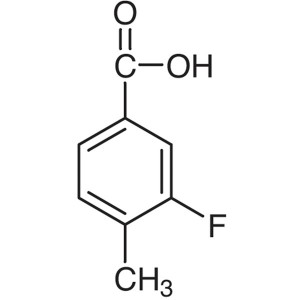
3-Fluoro-4-Methylbenzoic Acid CAS 350-28-7 Puri...
-
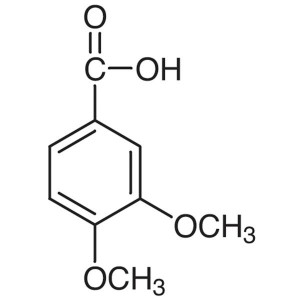
Veratric Acid CAS 93-07-2 3,4-Dimethoxybenzoic ...
-
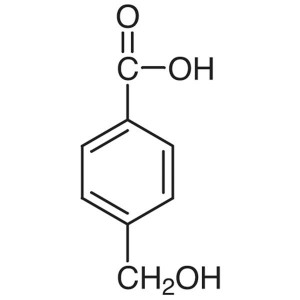
HMBA Linker CAS 3006-96-0 4-(Hydroxymethyl)benz...
-
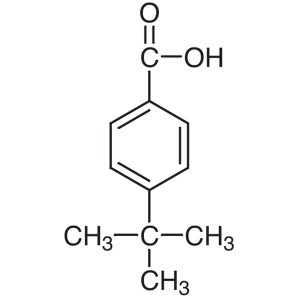
4-tert-Butylbenzoic Acid (PTBBA) CAS 98-73-7 Pu...
-
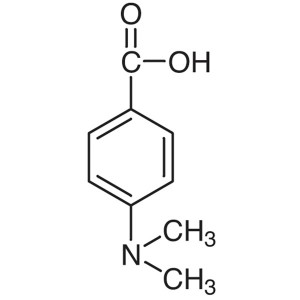
4-(Dimethylamino)benzoic Acid CAS 619-84-1 Puri...
-
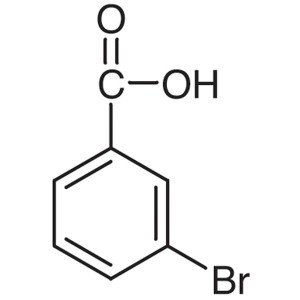
3-Bromobenzoic Acid CAS 585-76-2 Purity >99.0% ...
-
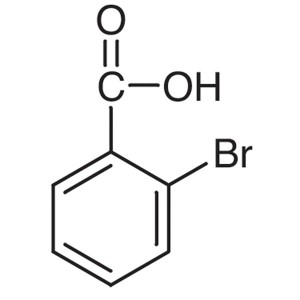
2-Bromobenzoic Acid CAS 88-65-3 Purity >99.0% (...
-
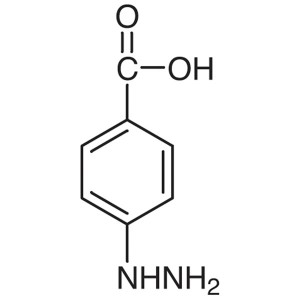
4-Hydrazinobenzoic Acid CAS 619-67-0 Purity >99...
-
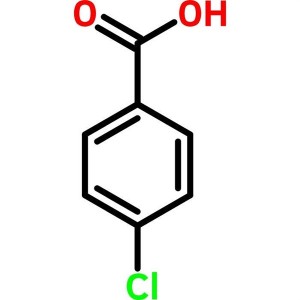
4-Chlorobenzoic Acid CAS 74-11-3 Purity >99.0% ...
-
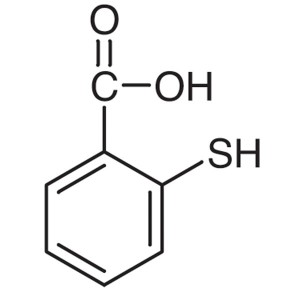
Thiosalicylic Acid CAS 147-93-3 (2-Mercaptobenz...

